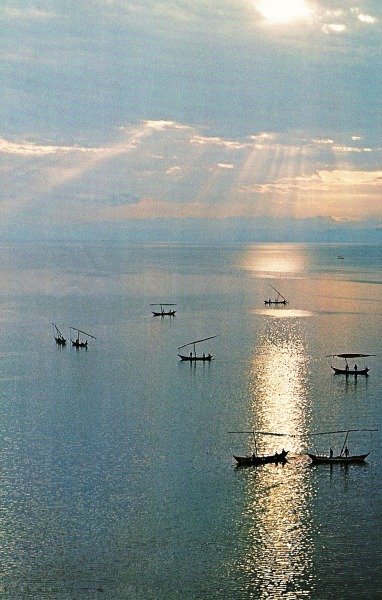~HELLO!! It's the last day of term! Hope everyone is doing well and ending it on a good note :)
Threats towards Ecosystem Services?
Through the posts from the past 2 to 3 weeks, it is clear that there are various complex interactions and feedbacks that occur between the socio-economic system of people and the ecological system of the ecosystems. While we have covered how climate change and climate variability might affect the functioning of lake ecosystem services, we have not covered in much detail the other anthropogenic threats that challenge these lake ecosystems and their services. Today's post will thus cover a fairly recent and short article on how ecosystems of lakes in Africa are under threat. Through such an understanding of humans' influence on ecosystem services degradation, there is hence a greater impetus for a more interdisciplinary and integrated management approach towards governing these lake ecosystems.
Ecosystem Resilience and Livelihood Strategies under Threat
African lakes have been described as highly productive centers of biodiversity providing critical ecosystem services that support the life cycles and livelihoods of species and humans respectively. Kafumbata et al. (2010) thus highlights that because of these key ecosystem services provided by African lakes, these areas have become 'magnets for migration and local centers of population growth'. The authors go on to explain the various anthropogenic threats of unsustainable resource management and exploitation that result from high demand by rapidly increasing populations of these lake areas (specifically for Lake Chad, Lake Chilwa and Lake Naivasha). Such anthropogenic threats relating to resource use and food security, along with climate variability were seen as the key challenges surrounding the management of African lakes. The authors then go on to introduce some programmatic responses to these challenges which largely revolved around more interdisciplinary and integrated approaches towards bridging knowledge generation and policy making, integrating the sustainability of natural resource management with livelihoods in light of future population demands and climatic variability.
Here are some of my thoughts on the article:
1) Anhropogenic impacts on African Lakes' ecosystems and their associated services
- High productivity of African Lakes: various provisional, regulating and supporting ecosystem services that benefit people living around the lakes
- People dependent on ecosystem services: food security and livelihoods (sale of resources)
- Authors point that lakes thus become 'magnets for migration' very valid
- Services and resources offered serve as a major pull factor to attract migrants and retain locals seeking social protection mechanisms for food due to social/ political/ climate disturbances
- Increasing demand due to population growth puts stress on ecosystems (negative anthropogenic impacts of various socio-economic activities like irrigation, fishing and harvesting)
- Authors also highlight how high levels of poverty might result in more unsustainable resource usage and inappropriate management of ecosystem given climatic variations
- ? Beyond simplistic argument of high levels of poverty, perhaps a clearer explanation behind unsustainable resource usage could be that of lack of knowledge and consequences by locals?
- ? As well as inadequate institutionalised 'safety nets' by governments during extreme events to help locals adapt: poor locals living near lakes are forced to prioritize short-terms needs over long-term sustainability?
> Negative anthropogenic impacts on lake ecosystems in Africa can largely be explained by the increasing demand being placed on the ecosystems and their associated services. The influence of socio-economic contexts and activities on ecosystem services functioning thus should not be underestimated and neglected. More importantly the degradation of ecosystem services have complex feedback effects on socio-economic contexts and activities as highlighted in the previous post because of the linkages and dependence of socio-economic activities on ecosystem services. Such complexity is further complicated by climate variability, affecting stocks and flows of ecosystem services and goods thus exacerbating feedback effects. Hence anthropogenic stresses along with climate variability serve as key factors that challenge ecosystem services functioning, and again the need for a more interdisciplinary understanding of interactions/ linkages between socio-economic activities and ecological processes/ ecosystem services is re-emphasized.
2) Towards a more integrated management approach?
- Authors go on to highlight integrated lake management plans being implemented in Lake Chad, Lake Chilwa and Lake Naivasha
- Authors also briefly explain how these management plans aim to reverse ecosystem degradation and achieve more sustainable natural resource and ecosystem service use that is in line with livelihoods and development requirements of locals
- Similar interdisciplinary approach towards understanding how ecosystem services and ecological processes are linked with socio-economic development was advocated throughout the different management plans
- Such an understanding is intended to bridge the gap between knowledge generation and policy level decision-making
- ? An interdisciplinary approach would also benefit from greater inclusion of local knowledge and perspectives - leading to more equitable and sustainable development as well ?
- Most importantly such an integrated and interdisciplinary approach that integrate sustainability of natural resource management with livelihoods can better inform policy makers to make decisions that will take into account future demands and climatic variations that will affect food security and ecosystem services
> The call for an integrated management approach is not necessarily in conflict with the call for more adaptive management highlighted in last week's post. Ultimately both articles emphasize on the need for a more interdisciplinary approach that takes into account interactions and linkages between socio-economic influences and ecological processes of ecosystem services. Similarly with adaptive management, integrated management would benefit from a more inclusive and equitable approach. More importantly the challenge of system heterogeneity or more specifically complex dynamic systems of lake ecosystems must similarly be addressed be management approaches - management approaches must recognise and embrace such heterogeneity and complexities.
THANKS for reading this post! Hope you have enjoyed this fairly short (I hope) article and wish you guys a good and enjoyable Xmas break! :)
~ Till Next Time ~

Photo of Lake Chad from National Geographic Society by John Scofield

